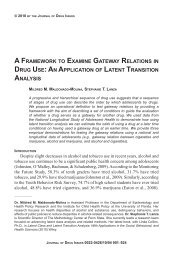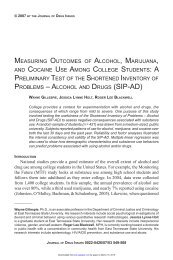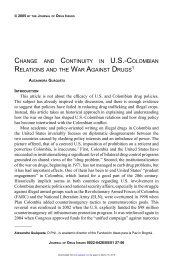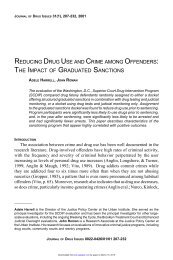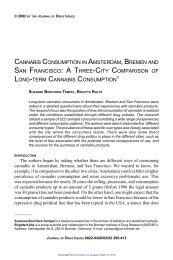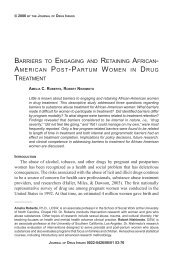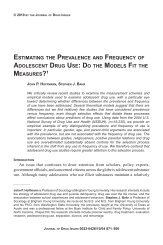control and welfare in danish drug policy - Journal of Drug Issues
control and welfare in danish drug policy - Journal of Drug Issues
control and welfare in danish drug policy - Journal of Drug Issues
You also want an ePaper? Increase the reach of your titles
YUMPU automatically turns print PDFs into web optimized ePapers that Google loves.
CONTROL AND WELFARE IN DANISH DRUG POLICY<strong>in</strong>stitutions. This meant that as subjects <strong>of</strong> Government, <strong>drug</strong> users were def<strong>in</strong>ed asnormal social citizens <strong>of</strong> the <strong>welfare</strong> state <strong>and</strong> no longer as deviant crim<strong>in</strong>als. Withreference to the literature on Dutch <strong>drug</strong> <strong>policy</strong> (Leuw, 1991; Grapendaal, & Nelen,1995) one could say that the dem<strong>and</strong> aspect <strong>of</strong> the <strong>drug</strong> problem was “normalized,”as it became a social problem that was no different to other social problems.FROM WELFARE TO CONTROLIn 2000, sensational reports on the widespread use <strong>of</strong> ecstasy among youngpeople, particularly at party venues, <strong>and</strong> reports on deaths attributed to ecstasy,once aga<strong>in</strong> made illegal <strong>drug</strong> use an important public issue. These sensationalistreports were underscored by surveys that revealed a large <strong>in</strong>crease <strong>in</strong> illegal <strong>drug</strong>use generally among young people <strong>in</strong> Denmark dur<strong>in</strong>g the 1990s (Hibell et al.,2000; Sundhedsstyrelsen, 2000). The surveys showed that cannabis was still byfar the most popular <strong>drug</strong>, but also revealed a trend toward the <strong>in</strong>creased use <strong>of</strong>stimulants. The new <strong>drug</strong> problem became part <strong>of</strong> a more general concern aboutthe use <strong>of</strong> <strong>in</strong>toxicat<strong>in</strong>g substances among young people <strong>in</strong> Denmark, as Europeansurveys showed that young people <strong>in</strong> Denmark consumed more alcohol <strong>and</strong> starteddr<strong>in</strong>k<strong>in</strong>g alcohol earlier than young people <strong>in</strong> any other country (Hibell et al., 1997;2000). An image <strong>of</strong> “a new culture <strong>of</strong> <strong>in</strong>toxication” (Measham & Bra<strong>in</strong>, 2005)among young people began to take shape that constituted a new <strong>drug</strong> problem(Balvig, Holmberg, & Sørensen, 2005; Ege, 2003; Gundelach & Järv<strong>in</strong>en, 2006;Østergaard, 2007). In 1999, the National Board <strong>of</strong> Health commissioned a qualitativestudy <strong>of</strong> experiences <strong>and</strong> attitudes toward <strong>drug</strong>s among young people <strong>in</strong> Denmark(Sundhedsstyrelsen, 2000) <strong>and</strong> <strong>in</strong> 2000, the Board conducted a series <strong>of</strong> regionalhear<strong>in</strong>gs to gather <strong>in</strong>formation about changes among young people on the <strong>drug</strong>scene. Both the hear<strong>in</strong>gs <strong>and</strong> the evaluation reported a more liberal attitude towardillegal <strong>drug</strong>s among young people. This more liberal attitude meant that illegal<strong>drug</strong> use was becom<strong>in</strong>g an <strong>in</strong>tegral part <strong>of</strong> the youth culture as such. The hear<strong>in</strong>gs<strong>and</strong> evaluation also reported that illegal <strong>drug</strong> use was particularly associated withthe night-time party scene where dist<strong>in</strong>ctions between legal <strong>and</strong> illegal <strong>drug</strong>s werebeg<strong>in</strong>n<strong>in</strong>g to fade <strong>and</strong> <strong>drug</strong>s were becom<strong>in</strong>g <strong>in</strong>toxicat<strong>in</strong>g consumer goods.Consumption has become more common: Young people do not lookat <strong>drug</strong> use as an isolated phenomenon among socially marg<strong>in</strong>alizedyoung people, nor as a trend that is “only” practiced <strong>in</strong> avant-gardetechno <strong>and</strong> hip-hop environments. Consumption <strong>of</strong> synthetic <strong>drug</strong>shas become modern <strong>and</strong> acceptable by the broad ma<strong>in</strong>stream<strong>of</strong> young people who enjoy a fast-paced youth existence full <strong>of</strong>experiences. [ . . . ] [T]he way young people use illegal <strong>drug</strong>s hascome to resemble the alcohol culture: it is acted out <strong>in</strong> public <strong>in</strong>FALL 2010791







